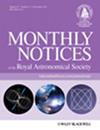Orbital architectures of planet-hosting binaries III. Testing mutual inclinations of stellar and planetary orbits in triple-star systems
IF 4.8
3区 物理与天体物理
Q1 ASTRONOMY & ASTROPHYSICS
引用次数: 0
Abstract
Transiting planets in multiple-star systems, especially high-order multiples, make up a small fraction of the known planet population but provide unique opportunities to study the environments in which planets would have formed. Planet-hosting binaries have been shown to have an abundance of systems in which the stellar orbit aligns with the orbit of the transiting planet, which could give insights into the planet formation process in such systems. We investigate here if this trend of alignment extends to planet-hosting triple-star systems. We present long-term astrometric monitoring of a novel sample of triple-star systems that host Kepler transiting planets. We measured orbit arcs in 21 systems, including 12 newly identified triples, from a homogeneous analysis of our Keck adaptive optics data and, for some systems, Gaia astrometry. We examine the orbital alignment within the nine most compact systems (≲ 500 au), testing if either (or both) of the stellar orbits align with the edge-on orbits of their transiting planets. Our statistical sample of triple systems shows a tendency toward alignment, especially when assessing the alignment probability using stellar orbital inclinations computed from full orbital fits, but is formally consistent with isotropic orbits. Two-population tests where half of the stellar orbits are described by a planet-hosting-binary-like moderately aligned distribution give the best match when the other half (non-planet-hosting) has a Kozai-like misaligned distribution. Overall, our results suggest that our sample of triple-star planet-hosting systems are not fully coplanar systems and have at most one plane of alignment.行星寄宿双星的轨道结构 III.测试三重星系统中恒星和行星轨道的相互倾角
多恒星系统,尤其是高阶多恒星系统中的凌星只占已知行星总数的一小部分,但却为研究行星的形成环境提供了独特的机会。行星寄宿双星系统中存在大量恒星轨道与凌日行星轨道一致的系统,这可以让人们深入了解此类系统中行星的形成过程。我们在此研究这种对齐趋势是否会延伸到行星寄宿的三合星系统。我们介绍了对寄存有开普勒凌星的三合星系统样本的长期天体测量监测。我们通过对凯克自适应光学数据的同质分析测量了21个系统的轨道弧度,其中包括12个新发现的三合星系统,对于某些系统,我们还利用了盖亚天体测量法。我们检查了九个最紧凑系统(≲ 500 au)的轨道排列情况,测试恒星轨道中是否有一个(或两个)与其凌日行星的边缘轨道对齐。我们的三重系统统计样本显示出对齐的趋势,尤其是在使用全轨道拟合计算出的恒星轨道倾角评估对齐概率时,但在形式上与各向同性轨道一致。当另一半恒星轨道(非行星寄存)具有类似于 Kozai 的错位分布时,如果一半恒星轨道由类似于行星寄存-二元对齐的中度对齐分布来描述,那么双群测试就能得到最好的匹配结果。总之,我们的结果表明,我们的三恒星行星寄宿系统样本并不是完全共面系统,最多只有一个排列平面。
本文章由计算机程序翻译,如有差异,请以英文原文为准。
求助全文
约1分钟内获得全文
求助全文
来源期刊

Monthly Notices of the Royal Astronomical Society
ASTRONOMY & ASTROPHYSICS-
CiteScore
9.10
自引率
37.50%
发文量
3198
审稿时长
3 months
期刊介绍:
Monthly Notices of the Royal Astronomical Society is one of the world''s leading primary research journals in astronomy and astrophysics, as well as one of the longest established. It publishes the results of original research in positional and dynamical astronomy, astrophysics, radio astronomy, cosmology, space research and the design of astronomical instruments.
 求助内容:
求助内容: 应助结果提醒方式:
应助结果提醒方式:


